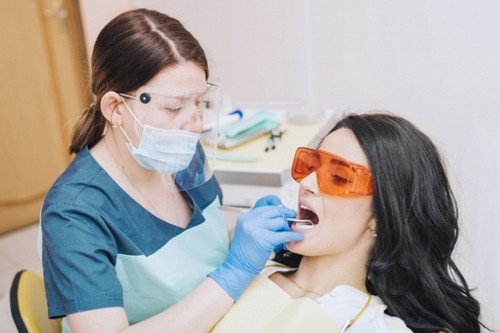Teeth may be stained or discolored for various reasons. Fortunately, making them brighter and whiter is quite realistic. There are several options to choose from. You can entrust this matter to the dentist or try homemade whitening products.
Despite some side effects, most whitening procedures are safe provided that you follow all instructions.
Your eating, drinking, and oral hygiene habits can affect how long your teeth whitening results last. After completing the course of procedures, your teeth are still prone to contamination from drinks – tea, coffee, and certain foods. Rinsing your mouth or brushing your teeth shortly after eating or drinking prevents these types of bleaching agents from settling on the surface of your teeth, reducing plaque formation.
As long as you adhere to methods approved by the dentist, teeth whitening is considered safe. Be sure to choose a method that suits your needs and always follow the instructions. Contact a specialist if you experience any side effects.
There are two main reasons:
- External discoloration is when food, drinks, or smoking stain your teeth. Coffee, tea, red wine, dyed foods, and tobacco can contribute to discoloration. External bleaching can be treated with whitening toothpastes.
- Internal discoloration occurs from within the tooth. It manifests itself due to medication, diseases, infections, tooth injuries or aging. In this case, professional whitening will help restore the whiteness of the teeth.
Teeth Whitening Options
There are three main categories of whitening methods that are:
- Performed by your dentist.
- Issued by the dentist for use at home.
- Are carried out at home without the supervision of a dentist using over-the-counter products.

You can choose a specific method of teeth whitening based on one or more factors, including:
- Type of discoloration.
- Cost.
- The method of the procedure.
- Age.
- History of teeth, including fillings and crowns.
The dentist will help you choose the appropriate method. He can recommend a treatment plan that best suits your needs.
Professional teeth whitening
The dentist can use several different methods of teeth whitening. As a rule, most often teeth are whitened with carbamide peroxide. This organic compound from hydrogen peroxide and urea is considered the most sparing among modern means of teeth whitening.
Whitening in the dentist’s office
The whitening procedure in the dentist’s office is considered the fastest method. In addition, the whitening effect usually lasts longer. Often, teeth whitening requires an hour of time or several such visits. This is due to the fact that the concentration of hydrogen peroxide in the products used is higher than in the products that you use at home. Dental bleaching is recommended if you have receding gums or abfraction (breaking off).
Your dentist may also use light when applying a whitening product to your teeth to speed up the process, but this additional method is controversial in effectiveness.
At-home whitening as recommended by your dentist
Your dentist can make and give you individually selected mouthguards. For teeth whitening, you will lubricate them with a special gel and wear from 30 minutes to 1 hour per day (in accordance with the recommendations of the dentist) for several weeks.

Teeth Whitening Products and Other Home Remedies
You can purchase over-the-counter whitening products designed for stained teeth. Unlike products prescribed by the dentist, these products do not contain urea peroxide or contain significantly less of it. This means that if the cause of the darkening of the teeth is internal, bleaches may not work as well, or it may take longer. When using products at home, it is always important to follow the manufacturer’s instructions.
Whitening toothpastes
Whitening toothpastes do not contain carbamide peroxide. They affect the surface of your teeth with various substances, including abrasives and blue covarine. Tooth whitening with toothpastes can take some time, however, pastes containing blue covarin are considered more effective, and due to their chemical composition, they can significantly whiten teeth after the first application.
Whitening strips
You can also purchase teeth whitening strips. They contain less hydrogen peroxide than professional products. All that is needed is to wear them once or twice a day on the teeth for a specified period of time specified by the manufacturer.
Activated Carbon and Other Home Methods
Activated carbon is one of the most common methods of teeth whitening at home. But the effectiveness of such methods has not been scientifically proven, so be sure to consult your dentist before use. You can damage your teeth if you use them without prior consultation.
Side effects and risks
Although tooth whitening is considered safe, you may encounter some side effects:
- Tooth sensitivity. Your teeth may become more sensitive after whitening. This can happen after the first or second procedure, but over time, discomfort should decrease. The dentist may recommend sensitivity treatment with drugs that contain potassium nitrate and sodium fluoride.
- Gum Irritation. It may appear due to the contact of your gums with a bleaching product. This side effect should pass after a course of whitening.
Remember that you cannot whiten your teeth permanently. Also note that all of the above methods are designed for natural teeth. You will need to talk with your dentist about how to improve the color of your teeth if you have implants, crowns, bridges or dentures.
A teeth whitening procedure may be contraindicated if you have active carious cavities or any other treatment is required.



